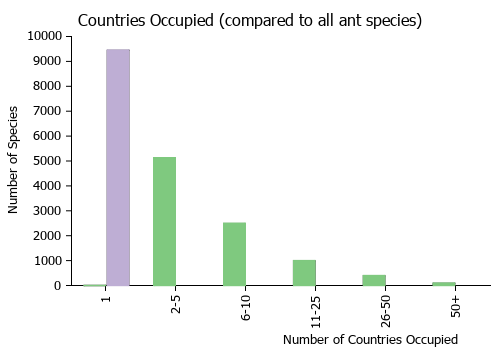Polyrhachis mucronata japensis
| Polyrhachis mucronata japensis | |
|---|---|
| Scientific classification | |
| Kingdom: | Animalia |
| Phylum: | Arthropoda |
| Class: | Insecta |
| Order: | Hymenoptera |
| Family: | Formicidae |
| Subfamily: | Formicinae |
| Tribe: | Camponotini |
| Genus: | Polyrhachis |
| Subgenus: | Myrmhopla |
| Species: | P. mucronata |
| Subspecies: | P. mucronata japensis |
| Trinomial name | |
| Polyrhachis mucronata japensis Donisthorpe, 1941 | |
Identification
Distribution
Latitudinal Distribution Pattern
Latitudinal Range: -1.833° to -1.833°.
| North Temperate |
North Subtropical |
Tropical | South Subtropical |
South Temperate |
- Source: AntMaps
Distribution based on Regional Taxon Lists
Indo-Australian Region: New Guinea (type locality).
Distribution based on AntMaps
Distribution based on AntWeb specimens
Check data from AntWeb
Countries Occupied
| Number of countries occupied by this species based on AntWiki Regional Taxon Lists. In general, fewer countries occupied indicates a narrower range, while more countries indicates a more widespread species. |

|
Estimated Abundance
| Relative abundance based on number of AntMaps records per species (this species within the purple bar). Fewer records (to the left) indicates a less abundant/encountered species while more records (to the right) indicates more abundant/encountered species. |

|
Biology
Castes
Nomenclature
The following information is derived from Barry Bolton's Online Catalogue of the Ants of the World.
- japensis. Polyrhachis (Myrmhopla) mucronata subsp. japensis Donisthorpe, 1941h: 63 (w.m.) NEW GUINEA. Donisthorpe, 1943d: 467 (q.).
Description
Worker
Differs from the typical form in having shorter pronotal spines, slightly longer epinotal and petiole spines, the latter more divergent, and the small teeth between the petiole spines shorter and more produced; otherwise like the type. Long. 5-6 mm.
Male
Blackish-brown, antennae, legs and articulation of the wings lighter, yellowish brown; mandibles pale yellow; whole surface finely coriaceous. Head small, longer than broad without eyes, posterior border and temples from eyes rounded; cheeks parallel; mandible feeble, unarmed, crossing when closed; clypeus large, transverse, anterior margin rounded, sinuate before sides; eyes very large, situated on each side of the head a little behind centre; antennae situated about the centre of upper surface of head; ocelli moderate, situated on top of head at base. Thorax narrow, longer than broad, broader anteriorly than posteriorly; pronotum very transverse and narrow; mesonotum large, flat on disc, mayrian furrows wanting, parap.sidal furrows distinct, continued from suture between prescutellum and mesonotum; scutellum very convex and prominent; epinotum longer than broad, gradually rounded from discoidal surface to declivity; node of petiole small, upper surface bluntly rounded, with two small projecting tubercles on the sides before base; gaster moderate, long oval, genitalia small. Wings pale yellowish-brown, pterostigma and veins pale brown. Long. 6 mm.
Type Material
Type Locality Information
Described from a male and 12 workers, JAPEN ISLAND: Mt. Baduri, 1000 ft., viii.1938 in a " papier-mache" nest on underside of palm leaf, col. Miss L. E .. Cheesman.
References
- Donisthorpe, H. 1941h. The ants of Japen Island, Dutch New Guinea (Hym., Formicidae). Trans. R. Entomol. Soc. Lond. 91: 51-64 (page 63, worker, male described)
- Donisthorpe, H. 1943e. The ants (Hym., Formicidae) of Waigeu Island, North Dutch New Guinea. Ann. Mag. Nat. Hist. 11(10): 433-475 (page 467, queen described)
- Pages using DynamicPageList3 parser function
- Need species key
- Tropical
- Subspecies
- Extant species
- Formicidae
- Formicinae
- Camponotini
- Polyrhachis
- Myrmhopla
- Polyrhachis mucronata
- Polyrhachis mucronata japensis
- Formicinae species
- Camponotini species
- Polyrhachis species
- Myrmhopla species
- Polyrhachis mucronata species
- Need Overview
- Need Images
- Need Body Text